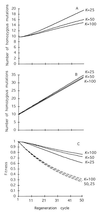Deleterious mutation accumulation and the regeneration of genetic resources
- PMID: 9419386
- PMCID: PMC18235
- DOI: 10.1073/pnas.95.1.394
Deleterious mutation accumulation and the regeneration of genetic resources
Abstract
The accumulation of mildly deleterious mutations accompanying recurrent regeneration of plant germ plasm was modeled under regeneration conditions characterized by different amounts of selection and genetic drift. Under some regeneration conditions (sample sizes >/=75 individuals and bulk harvesting of seed) mutation accumulation was negligible, but under others (sample sizes <75 individuals or equalization of seed production by individual plants) mutation numbers per genome increased significantly during 25-50 cycles of regeneration. When mutations also are assumed to occur (at elevated rates) during seed storage, significant mutation accumulation and fitness decline occurred in 10 or fewer cycles of regeneration regardless of the regeneration conditions. Calculations also were performed to determine the numbers of deleterious mutations introduced and remaining in the genome of an existing variety after hybridization with a genetic resource and subsequent backcrossing. The results suggest that mutation accumulation has the potential to reduce the viability of materials held in germ plasm collections and to offset gains expected by the introduction of particular genes of interest from genetic resources.
Figures



References
-
- Frankel O H, Brown A H D, Burdon J J. The Conservation of Plant Biodiversity. Cambridge, U.K.: Cambridge Univ. Press; 1995.
-
- Smith R D, Linington S H. In: Plants for Food and Medicine. Etkin N L, Harris D R, Prendergast H D V, editors. Kew, U.K.: Royal Botanical Gardens; 1997. , in press.
-
- Crossa J, Vencovsky R. Theor Appl Genet. 1994;89:936–942. - PubMed
-
- Brown A H D, Brubaker C L, Grace J P. Crop Sci. 1997;37:7–13.
-
- Clark R L, Shands H L, Bretting P K, Eberhart S A. Crop Sci. 1997;37:1–6.
Publication types
MeSH terms
LinkOut - more resources
Full Text Sources

